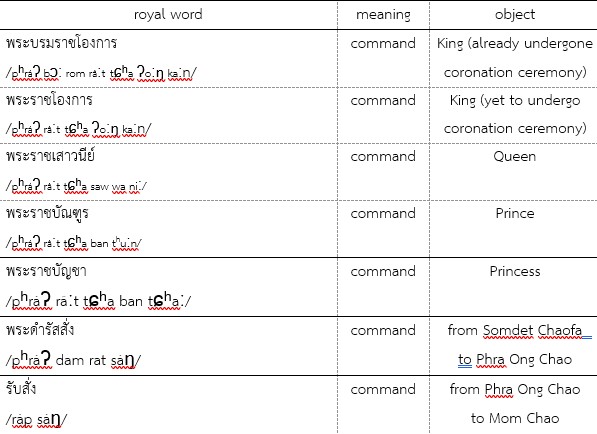Tassnee Khamsaengtong A Study on Royal Affixes in The Thai Language
Main Article Content
Abstract
DOI : 10.14456/pnuhuso.2024.12
With the progress of civilization, various factors, including regional interactions, trade, religious beliefs, and cultural influence, have contributed to the assimilation of a considerable number of loanwords into the Thai language. The utilization of affixes for word formation has emerged as a key mechanism in Thai Lexical Formation, giving rise to a standardized structure known as "royal language". Linguistic phenomena arising from development processes evolve into lexical entities within the Thai language system. In this study, the author, therefore, focuses on explaining and analyzing characteristics that encompass both grammatical and semantic properties. This study reveals the complex nature of complex word formation, with the author delving into the standards, characteristics, scope, classification, and functions of royal vocabulary in detail.
Article Details

This work is licensed under a Creative Commons Attribution-NonCommercial-NoDerivatives 4.0 International License.
References
Joos, M. (1962). The Five Clocks. Research center in anthropology, folklore, linguistics. Indiana University.
Khanittanan, W. (2001). Khmero-Thai: The great change in the history of Thai language in the Chao Praya basin. Language and Linguistics, 19(2), 35-50. https://so04.tci-thaijo.org/in dex.php/joling/article/view/181026/128435
Kupfer, P (2017). Chinese lexical teaching based on "morphemes". International Chinese Language Teaching Research, 13(1), 23-30.
Ngamwises, W. (2012). Royal Vocabulary: Principles of Thai Language Usage Worth Knowing. Pumipanya Publishing.
Office of the National Identity Development. (2012). Royal Vocabulary: Celebrating the auspicious occasion of the Royal Coronation Ceremony, Rama IX, on December 5, 2011 (4th ed.). Dansuttha Printing.
Panmieta, B. (2001). STRUCTURE OF THAI. RamkhamHaeng University Press.
Prasithrathsint, A. (2002). Language in Thai society: Diversity, change, and development. Chulalongkorn University Press.
Pisit, W. (1959). Principles of Thai Language. Chulalongkorn University Press.
Pei, X. (2001). A new compilation of Thai grammar. Beijing: Peking University Press.
Smalley, W. A. (1994). Linguistic diversity and national unity: Language ecology in Thailand. University of Chicago Press.
Srihaamphai, P. (2007). Language and Culture. Chulalongkorn University Press.
Sikkharit, Y. (2009). The development of the royal terms during the Sukhothai period to the pre-revolution of 1932 [Master’s thesis, Silpakorn University]. https://sure.su.ac.th/ xmlui/handle/123456789/4441
SikkhaRit, Y. (2016). A comparative study of Thai and Khmer royal vocabulary from diachronic Perspective [ Doctoral dissertation, Chulalongkorn University]. http://cuir. car.chula.ac.th/handle/123456789/59148
Tiewcharoenkij, A., Kanokkamalade, V., & Pankhuenkhat, R. (2022). The Evolution of Thai Language. The Journal of Sirindhornparithat, 23(1), 364-375. https://so06.tci-thaijo. or g/index.php/jsrc/article/view/248987/172778
Wongcha-oum, M. (1986). Poetic license in the Ayudhya period [Master’s thesis, Silpakorn University]. http://www.thapra.lib.su.ac.th/thesis/showthesisth.asp?id=0000000140
Wu, F. (2021). A typological study of Southeast Asian languages. Lecture Series on Regional Typology. Renmin University of China.


